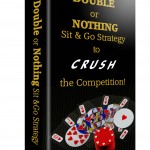Double or Nothing Sit and Go Poker Review
I read carefully both volumes of the Double and Nothing SnG Strategy (which will be referred as DoN from onwards) and then proceeded to play a few of these single table tournaments to test out what I had learned.
I proceeded to do very well and cashing in 9 out of 12 of these tournaments for a small profit. Now I know this is a small sample, I do have a lot of poker experience and there is some luck involved but I am extremely confident that if you utilise the advice given in these two volumes, you will win in the long run.
What I must stress is that this guide enabled me to make the necessary modifications in order to profit in the long run. I even managed to fold Aces pre flop, if you purchase this book, you will discover why!
What is a DoN?
 A DoN is a single player tournament consisting of 10 entrants. Of the 10, only 5 will double up their buy in and the remaining 5 will lose their buy in.
A DoN is a single player tournament consisting of 10 entrants. Of the 10, only 5 will double up their buy in and the remaining 5 will lose their buy in.
Unlike the traditional Sit ‘N go, there is no payout difference between finishing in 1st of 5th, therefore the traditional Sit ‘N Go strategy books do not apply. These tournaments are a relatively low risk and fun way to build your bankroll and as a result, have therefore become hugely popular.
Volume I
The first volume is the basic guide. It is geared towards players who have little experience of playing these types of tournaments. It is written in easy to understand terminology and there is very little complicated Maths involved.
The first point stressed in this volume is bankroll management. There is also helpful advice about how many of these you should play at any one given time and why.
The guide then moves onto key concepts such as:
- Why generally playing tight is the way to win;
- Why it is important to have the discipline to fold big hands when there is only 1 player left until cash (even AA);
- When should you consider just ‘pushing all in or folding’;
- Steals and re-steals;
- Stack size considerations.
Next, the guide speaks about hand considerations in key levels including:
- 25/50
- 125/300 (with 10-9 players, with 8-7 players)
- 125/300 and above (with 6 players remaining)
Crucially, all this theory is put into numerous practical real life hand situations towards the end of the firsts volume. The answers are detailed and easy to understand. An example being:
Ten players remain in the beginning of the tournament. With the blinds at 15/30 you are UTG+2 with 1470 in chips. You are dealt 6h6s. UTG limps and UTG+1 folds. What do you do? Answer. Call. You are in early in the tournament and hoping to build your stack a little by hitting a set. If you don’t hit you can get away from this hand and only lost a small dent in your chips. You call. MP1 calls and MP2 raises to 90. There are 4 folds and the BB and UTG call. There is 345 in the pot. What do you do? Answer: Call. The situation has not changed much from the last hand. There are multiple people in the pot and you have the opportunity to win a nice pot if you hit your set. While you want to be careful not to let your stack dwindle during the early stages of a tournament, trying to hit a set early in the tournament is almost always a good situation. However, I wouldn’t call more than 100 there to try to hit the set.
Volume 2
Volume 2 is a companion to Volume 1 and consists of 37 real-life examples similar to the one above, including how to play certain hands in:
- Early game;
- Middle game;
- Bubble examples;
Conclusion
In my opinion, only the first volume would have been worth the investment of only $19.99 (£12.64). It is great that you receive the second volume for the same price. Please take advantage of this great offer before you register for your next DoN tournament. You won’t regret it!



